The story about Fin is really a story about an Australian who single handedly set about to make the best possible racquets in Taiwan and launch the low cost of production graphite racquets into the global market and in the process establish himself as the foremost designer and innovator of racquet design with graphite technology.
Barry Todd was looking for a business opportunity in the late 1970′s and a friend had just returned from Taiwan with some metal and wooden tennis racquets. After three hits the metal welding broke, the tennis balls were flat, the wooden laminations started to separate, yet these items were bought only for $6 whereas the current market was paying $30. Appearance wise they looked OK, it was only that their production and materials specifications were all wrong.
The only option was to fly there and start to work with companies to develop better technology that wouldn’t fail. The starting point was Pro Kennex. Barry refined the graphite formulas and techniques to create a range of racquets which he then took to America’s largest trade show and introduced Taiwanese Graphite to Wilson, Prince, Head and Donnay. His expertise included being able to design and produce a new model within 4-6 weeks compared to the usual 12-18 months manufacturers were used to waiting for. Orders rolled in. Graphite racquets were certainly being made pre Barry visiting Taiwan because Emrik and Stellar were already marketing Taiwanese graphite product while Rossignol, Kawasaki and other brands were using high cost Japanese, European or USA production facilities.
While the first orders were small, Barry was able to manage the business, however as the orders grew in size, his role as middleman was marginalised as the factories began to deal directly with the large brands. Unfortunately, this same pattern continued as Barry was forced to leave one firm to assist another in an attempt to forge an income and sadly the “sell-out” process continued.
For two years Barry lived in Taiwan, he forged ahead with numerous innovations including the deep throat designs, the manufacture of synthetic gut and grips all of which were adopted and copied.
The technology advancements also moved into squash racquet design and amid a major backlash which was fought out in the courts (not on them) the International Squash federation was forced to accept the new racquets over the conventional wood. I can hear my Real Tennis colleagues saying they are glad that their secretive 300+ year sport thankfully remained off the radar.
Barry as a player was no slouch, he used to be up there with Fred Stolle, Bob Hewitt & company but it was pretty difficult to make a name when Rod Laver and others were at the elite end. While living in Taiwan, he was the only foreigner ever to win the Taiwan Open, for they changed the rules after this to be a “Taiwanese Only” tournament.
With the limited personal financial success of the introduction of high volume graphite racquets, a variety of consultancy positions and some major brand R&D roles that failed to materialise, Barry decided to create his own brand, FIN. Given his design expertise he recognised the importance of vibration on tennis elbow and proceeded to develop the first in-frame vibration dampening system involving a split throat design called “VFS”. This was introduced into the top end range of the Fin IQ racquets. The racquets received excellent PR particularly in the USA when the publisher of a tennis magazine found he could play again, after years of tennis elbow with the new FIN IQ’s. Protecting the system also came at a price. To patent technology globally cost $130,ooo and then you need deep pockets to protect your patent against would be copy-cats. He also fine-tuned manufacturing to incorporate a range of weight and balancing variations to create a range of racquets for major players. The biggest name in the Australian market to use Fin was Chris Lewis from New Zealand.
The new range and network of agents was in place for the 1982 German Sporting goods show and in a matter of days Barry and team had amassed a staggering $3 million in orders.
Success comes at a price and Barry had to quickly find a way to fund order production. The plan involved advertising for funding throughout Europe and 167 offers of support came in.
The one chosen was a group of Forklift truck manufacturers with some $60 million in turnover and with the offer to inject the funds quickly Barry signed a deal giving them 51% and control of the business. In yet another disastrous chain of events, this new investor was in fact cash strapped themselves and by the time the letters of credit had been organised with the Taiwan factory, the European summer was over and the orders could not be fulfilled. Over in Australia, production was on time for the coming summer season, hence the FIN brand managed to grab a foothold in the Australian market.
On the IQ frames the following is labelled, ” This model is part of the new Fin tailor made collection of super performance racquets assembled in Taiwan. The exact cross blend by braiding the fibres together eliminate human error in the manufacturing process giving 100% uniformity throughout the racquet. This process combined with unmatched technology makes these racquets the most responsive racquets on the market today” Tag line FEEL THE FIN DIFFERENCE. (s0me Asian grammar retained)
Despite the rocky start, Fin survived for about 6 years even though the company was struggling financially. In an attempt to resurrect the business Barry began to seek some joint venture arrangements. One of these was Prince. At the time he was to first meet them, he instead had to return to Australia for his daughters wedding and various Fin UK board members followed him out attempting to negotiate a restructure of senior management. Barry would have none of this and on his return to the UK found that the board, with control, had decided to sack Barry from his position. Daft in the extreme since Barry was the technological genius behind the Fin range. The Prince deal never got off the ground.
Regrettably, he had to sit back and watch the financial disaster unfold and Fin went broke along with his 49% share. No doubt, if the financial gods had been favourable, Fin may well have become, deservedly so, a major racquet brand which may well have been around today.
The next foray into the market was thanks to a mate who owned the Deesse (pro. Dayus) company in Switzerland. They are today still a large cosmetic company and were keen to develop their own range of sporting goods because they used sporting wear and equipment in many brand promotions. Given a solid financial base, Barry went to Korea this time to develop the range which included the “woody” graphite style which is a quite stunning finish, he also designed the long string concept and the inward angle of the side frame. In two years Deesse racquets were number 1 in Switzerland and then a deal was done for Barry to launch Deesse into the UK as his own business and globally with Deesse into other markets. Again, another tragedy. Owing to a severe car crash Barry was hospitalised and his potential future involvement with the project was in doubt. Deesse decided to pull the pin rather than continue without him and cutting it’s losses withdrew from the launch meaning that Barry was once again denied his opportunity.
Barry, today aged 72 has retired from tennis racquet manufacture but he still owns some major patents available for a price. Sadly the journey has not been kind to Barry financially but the story itself is a great tribute to his Australian ingenuity and his “have a go- never give up” attitude.
He certainly paved the way to the greatest revolution in tennis playing style and techniques for the power generated by graphite racquets has altered stroke making, ball spin, court play and the retail market. Remember that we used to buy one or two racquets a year when we played club tennis now we can own a graphite one for ten years….
From this story, I guess the only irony is that even today the greatest problem facing the racquet industry continues to be what plagued Barry and that is the ongoing knock offs created by rogue factories, not just copying technology but creating full graphics knock offs.
Thanks for your time Barry and sharing your story with tennishistory.com.au
Fin metal products were launched with the graphites.
Fin IQ 300 with VFS vibration system
A stunning design all round
Deesse (pron. Dayus) Woody Graphite
One of the most attractive racquets made. Barry created the technique to print a wooden finish using various shades.
An earlier Deesse model called the WIZARD Feather Pro
In a fashion like the Wilson PWS, Deesse used the long string technique
combined with additional frame support as shown here.
Apart from developing the first long string racquets, Barry also produced this alternate stinging system.
If you broke a string, the immediate strings would remain taut allowing you to complete the point.
A fine and rare example to include in any collection, called the MIRACLE (blue one side pink the other)

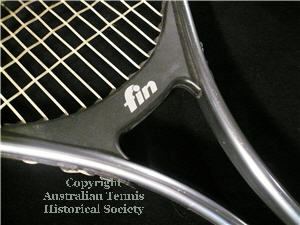

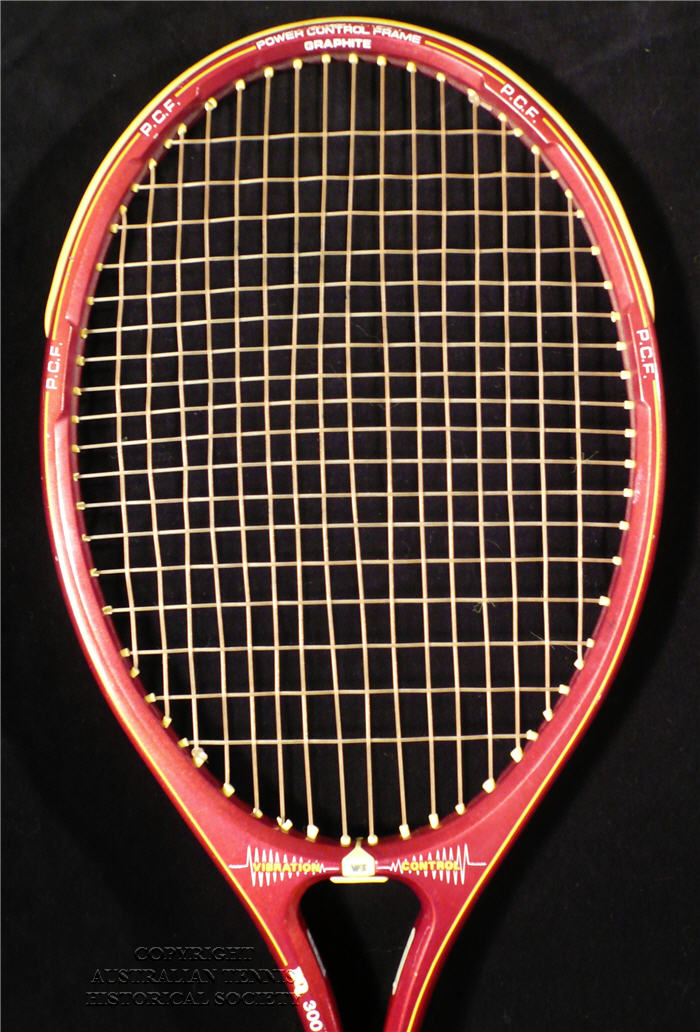
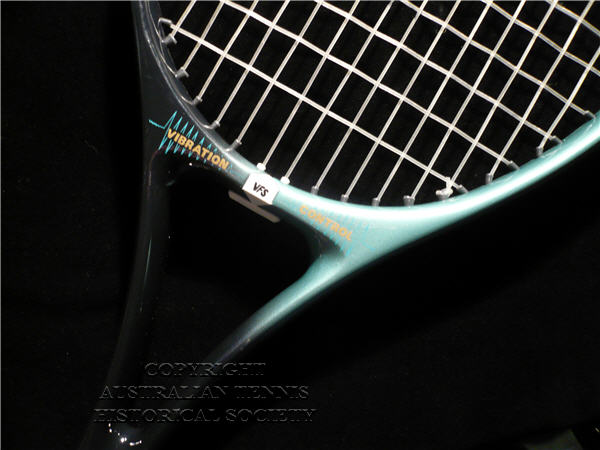
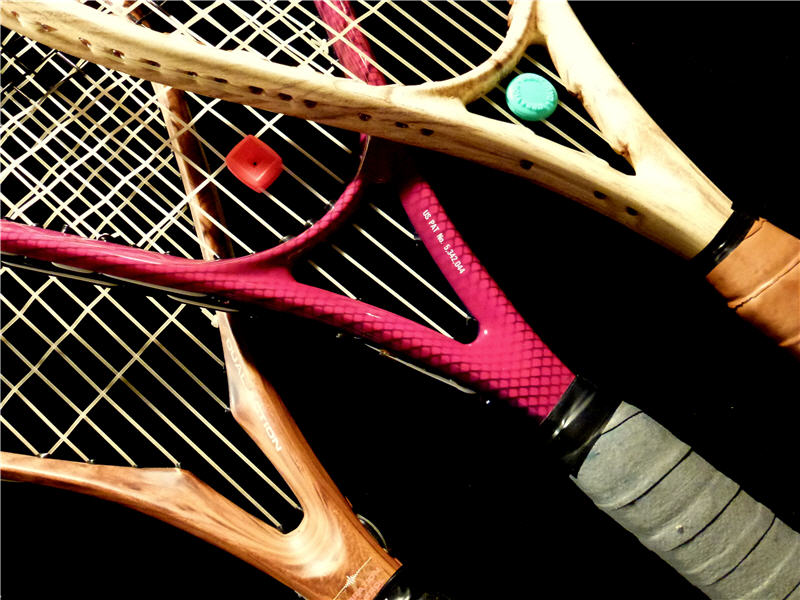
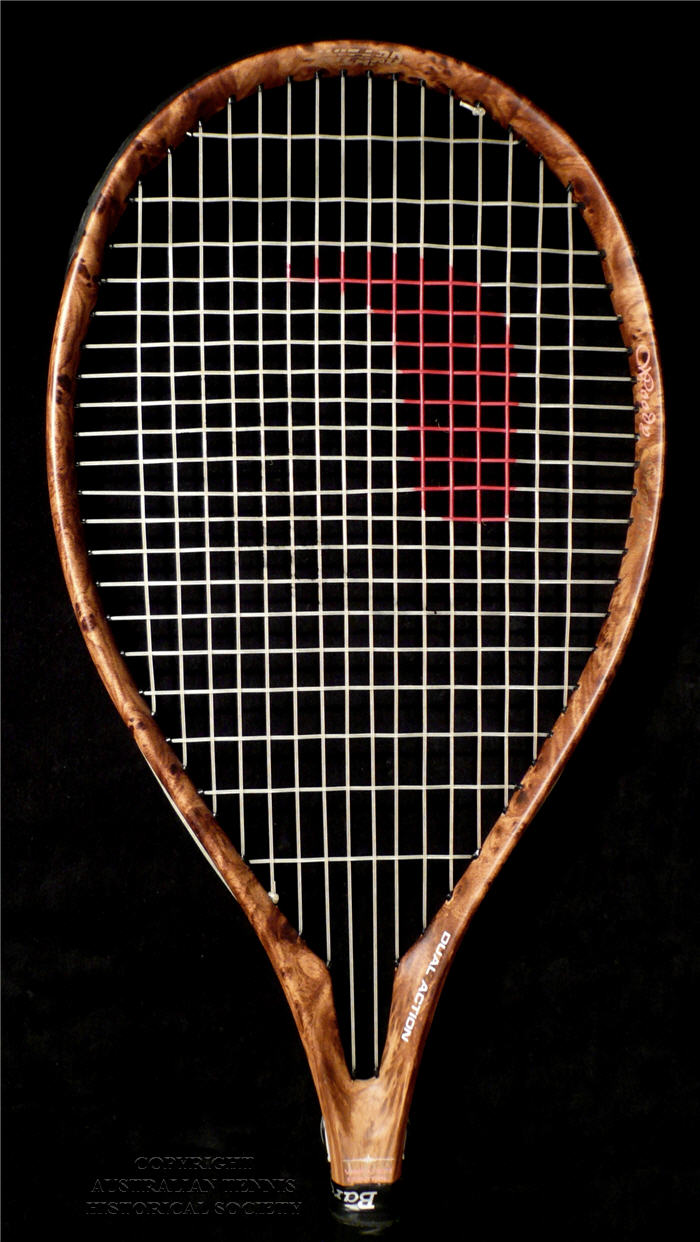
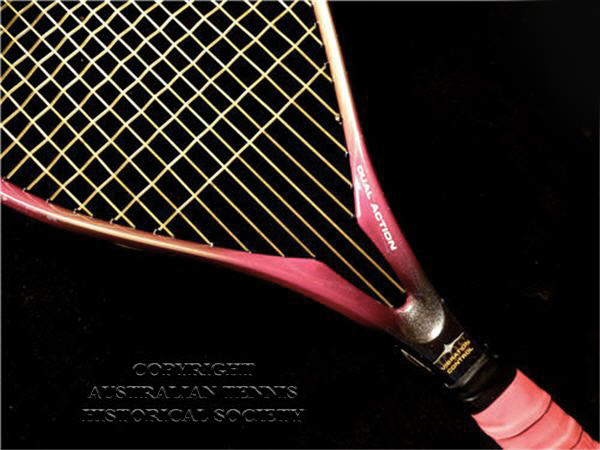
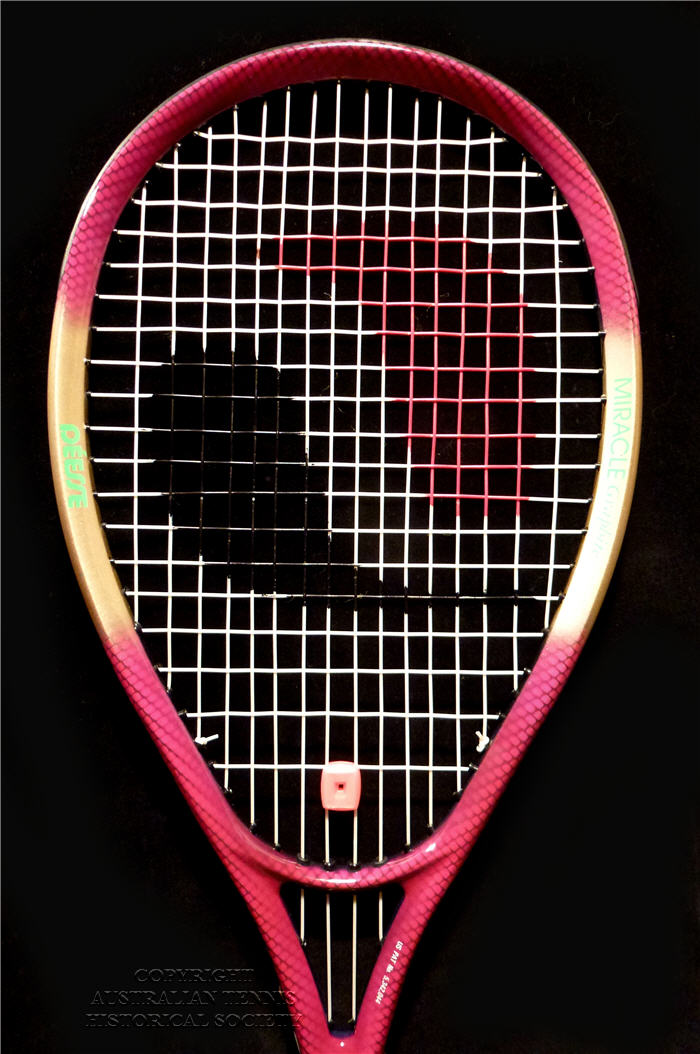


You must log in to post a comment.